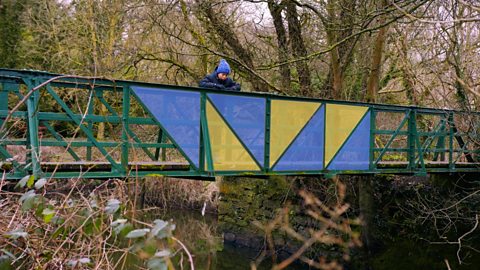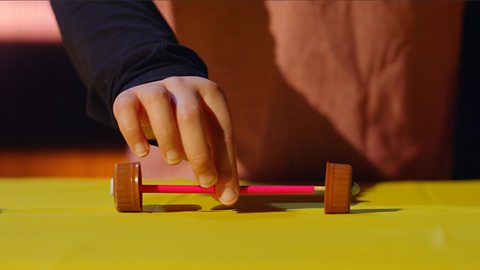These guys are building a den for their garden.
Oh dear! It’s starting to rain and that cardboard den is not waterproof!
Umbrellas are made out of waterproof material and the slanted shape means the rainwater runs right off, keeping us dry.
That’s an idea – the umbrellas could keep the den dry!
Oh dear… maybe not!
Some coats have a special waterproof coating which means that water runs off them.
Just like a raincoat, this plastic sheeting could stop the rain getting into the den.
Oh dear, there’s a lot of water there. I’m not sure that the cardboard can… oops!
At least they can keep nice and dry inside.
Their house has a slanted roof. Just like the umbrella the rain runs straight off it.
And the roof is made from roof tiles which are waterproof like the coat.
Oh, that is a good idea. They’ve made a new den by slanting two bits of wood together like a roof.
Any water would run straight off.
But wood isn’t waterproof, so water might still leak into the den.
Great! They’re using the plastic material that has the special waterproof coating. The rain will run right off that.
A perfect, waterproof den. Good job!
Video summary
Follow two primary-aged pupilds as they build a den in their garden and learn how make it waterproof.
This short film is an ideal introduction to any design and technology unit dealing with construction.
It demonstrates practical activities that pupils can carry out in the classroom, or at home, to make something waterproof.
Teacher Notes
This short film is an ideal tool to introduce pupils to techniques that can be used to make structures waterproof.
As they watch the film, pupils can give their own thoughts on why they think certain materials offer more protection from water that others.
Pupils can also try to relate their ideas to real life and everyday objects around them, linking theory to practice.
Points for discussion:
- What considerations have to be taken into account when building a structure that has to be waterproof?
- Which materials are the best for making something waterproof?
- How can we make something more waterproof?
- What would happen if we were not able to make things waterproof?
Suggested activities:
After watching the film, you could work with pupils to assess how waterproof structures are in different contexts.
Pupils can be given the opportunity to build their own waterproof structures, make predictions about how waterproof they will be, and then test their theories.
Pupils could carry out practical activities to make things more or less waterproof. They could relate these explorations to everyday objects, or research different structures in books or on the internet.
Suitable for teaching design and technology (D&T) at KS2 in England, Wales and Northern Ireland, and 1st and 2nd level in Scotland.
How to make a structure stronger. video
Join three primary-aged pupils as they build different types of towers and learn how to make them stronger.

Axles. video
Two primary-aged pupils show us how to make balloon cars to help us understand how axles work.

Hinges. video
In this short film we observe two primary-aged pupils as they make simple hinges for their treasure boxes.
